Everyone who went through adolescence had to become familiar with skin rashes on the forehead.
It is during moments of powerful hormonal changes that the forehead “blooms” with blackheads, rashes and red acne. Careful hygiene, antibacterial cosmetics, tons of camouflage products, long bangs and fashionable hats - how is everyone coping with this difficult time?
But now, teenage age is long behind us, and the acne on the forehead is still there. This means that not everything is fine in the body, and you need to look for the causes of this trouble in its depths.
Reasons for appearance
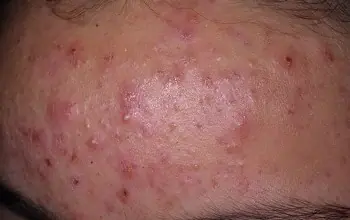
It is characterized by high fat content and requires careful care and the use of special cosmetics.
Increased secretion of sweat and fat helps create a favorable environment for bacterial activity, hence frequent inflammatory rashes on the skin of the forehead.
It is the forehead that is the first to react to errors in nutrition, hormonal surges and problems in the internal organs.
If acne is a frequent guest on the forehead, it is necessary, first of all, reconsider your diet and care. And if these measures do not help, then it’s worth looking for the cause using medical examination.
Let's consider what factors provoke rashes on the skin of the forehead:
Improper skin care
Careless cleansing of the skin, inappropriate cosmetic products, the use of comedogenic products, heavy makeup - all this leads to clogged skin pores and the rapid development of microbes that cause the growth of pimples.
Unhealthy diet
It is known that our food directly affects the condition of our skin. Abuse of fatty, spicy, and sweet foods has a bad effect not only on your figure, but also provokes rashes on the surface of the forehead - this way the body is cleansed through the skin of intoxication with harmful products.
Hormonal imbalance
Hormonal surges increase the oiliness of the skin, so young people during puberty, women during menstruation and during pregnancy suffer from acne. Rashes on the forehead normally go away on their own with the restoration of balance in the body. Pathological endocrine conditions, such as hyperandrogenism in women, are also the cause of acne on the forehead, but such manifestations require mandatory treatment.
Gastrointestinal problems
Digestive disorders also have a bad effect on the skin. If you have pimples on your forehead, you can suspect diseases of the liver and gallbladder (indicated by pimples close to the hairline) or intestines (rashes above the eyebrows).
Irritation
Pimples on the forehead may well be the result of wearing poor headwear (friction, pressure, synthetic materials), intense sweating of the head (for example, when playing sports), or an allergic reaction. Such acne disappears if the cause of its occurrence is eliminated.
How to remove acne on forehead?
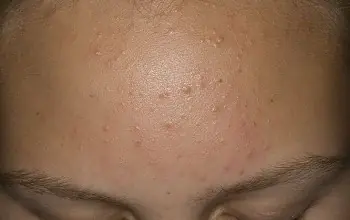
But external treatment alone is not enough.
Without following a diet and cleansing the body, acne will occur again and again.
Getting rid of small pimples
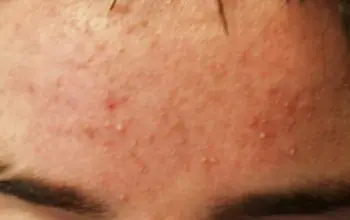
If you suspect an allergy, you should immediately take an antihistamine.
But most often, it is poor hygiene and abuse of makeup. The problem with small pimples on the forehead can be aggravated by attempts to “cover up” them with foundation, wearing a hat, or contacting the skin with bangs.
When small pimples appear on your forehead, the first thing you should try is to change your skincare and decorative cosmetics. It is advisable to avoid oily creams.
You should cleanse your skin thoroughly twice a day and then use medicated products to remove the rash.
Products with antimicrobial components (acne ointments), drying with lotions with salicylic acid, washing with tar soap, clay-based masks, rubbing with chamomile decoction help to reduce the rash.
The best thing is to contact a cosmetologist and do mechanical cleaning: the master will steam the skin and, using sterile instruments, carefully squeeze out all pimples, perform disinfection, soothing drying mask, and apply a medicinal cream.
The same thing can be done at home, but there is a risk of infection and further worsening the condition of the forehead.
Treatment of inflamed acne
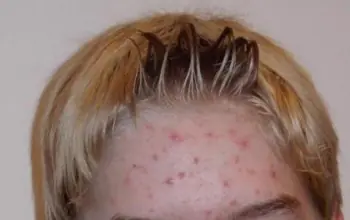
The temptation to squeeze out such pimples is great, but it is possible that everything will get even worse.
Squeezing will not eliminate the inflammation: after a few hours the pimple will be back in its place.
The same things help relieve inflammation anti-acne ointments (“Baziron”, “Skinoren”, “Retin A”).
Among the folk remedies, we can recommend lubricating the pimples every night with toothpaste or a mixture of zinc ointment with salicylic acid - it is applied to each pimple once every 3 days.
Has an anti-inflammatory effect blue clay mask: For 2 parts clay powder, take 1 part water and lemon juice, a few drops of aloe and cucumber juices. Keep the mask on your face until it hardens, then rinse with warm water. Course – every other day, 4 – 6 times.
If there is a predisposition to the transformation of comedones into red pimples, it is better to wash your face oatmeal. Take oatmeal without additives, soak it in water and wipe your face with the paste. This type of washing promotes gentle exfoliation, cleanses pores, evens out the skin and reduces breakouts.
Fighting "subcutaneous"
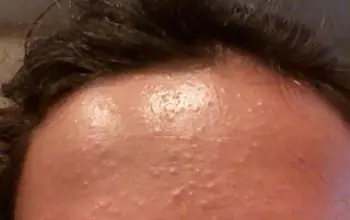
The peculiarity of such acne is the formation of a subcutaneous cyst, where fatty secretions accumulate. A painful lump appears on the forehead, inside of which suppuration develops.
Subcutaneous pimple should not be squeezed.
It is impossible to squeeze out an immature subcutaneous tissue, but it is easy to injure the skin and cause an infection, as well as develop “post-acne” - scars and dark spots at the site of the cyst after healing.
The subcutaneous pimple needs to be “pulled” out with the help of ointments (ichthyol, Vishnevsky), compresses with aloe juice, local antibacterial drugs (Baziron, Zinerit, Differin and others).
Removing purulent acne from the forehead
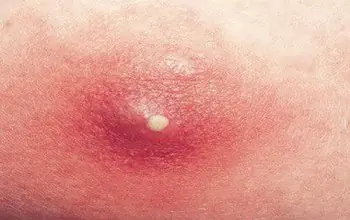
Also, do not forget that under no circumstances should you “scrub” your forehead if there are red, inflamed pimples on it.
The second reason for the appearance of ulcers on the forehead is colds.
When treating large purulent pimples, antibiotic therapy may be needed, both local (with antibacterial ointments) and general. Tablets are usually prescribed if ulcers are accompanied by fever.
After the acute condition is relieved, treatment can be concentrated on drawing out the purulent contents. For this, compresses with tar ointments, cabbage juice, and aloe are most effective.
What to do if acne doesn't go away?
“Painful” pimples on the forehead are a sign of an inflammatory process in the skin.
Unlike regular acne, these types of pimples cannot be cured with cleansers and lotions. You can’t do this without consulting a dermatologist and an integrated approach.
Cleansing the body, hygiene, using hypoallergenic and non-comedogenic cosmetics, and a healthy diet should improve the condition of the skin in general and clear the forehead of acne as well.
If, despite all the measures taken, acne on the forehead does not want to leave its “home” place, then the problem is not in care or nutrition, but much deeper.
In addition to a dermatologist, it is necessary to undergo examination in gastroenterology, gynecology, and endocrinology. It would not hurt to consult an allergist-immunologist. After identifying and treating the underlying pathology, its external manifestation - acne on the skin of the forehead, will disappear on its own.
Preventing acne on the forehead
Prevention of acne on the forehead comes down to maintaining cleanliness and overall health of the body:
- Cleansing the intestines and entire gastrointestinal tract: eat the “right” food, give up fatty foods, flour, fried, sweets. More fresh vegetables and fruits, lean meat and fish, dairy products. Drink plenty of clean water. Take preventive courses of sorbents. Restore intestinal microflora.
- Skin hygiene: Thorough washing, moisturizing morning and evening. Use products that regulate sebum secretion. Remove dead skin cells (acid creams, masks, peelings). Regularly visit a cosmetologist or do facial steaming and mechanical cleaning of pores yourself. Choose your cosmetics wisely and do not overuse heavy makeup.
- Keep your hair fresh. Oily hair, styling products, and dandruff come into contact with and negatively affect the condition of the forehead skin.
- Treat your illnesses, strengthen your immune system and lead a healthy lifestyle – and clear skin is guaranteed.
The prevalence of acne during puberty reaches almost 100% in both boys and girls equally, but in a later period (after 20 years and even 40) the disease is more typical for women. Just like in youth, acne appears on the forehead, chin and cheeks. The factors influencing their education are numerous. Equally, if acne appears on the forehead, the causes in women may be related to genetics, health conditions and environmental factors.
Why do pimples appear on the forehead?
In order for acne to appear on the forehead, several factors must work at once:
The cells of the stratum corneum of the gland ducts thicken, grow, and begin to exfoliate intensively. As a result, a plug of sebum and desquamated scales is formed - a comedon (open or closed). According to one version, this process is activated by a lack of linoleic acid, an increased level of male sex hormones and an increase in the enzyme that converts testosterone into a more active form, dehydrotestosterone, which enhances the production of sebum and cell proliferation.
- Increased sebum secretion
Against the background of hyperkeratosis and the formation of plugs, the production of sebum provides favorable conditions for acne bacteria, since the fats in sebum (sebum) provide a breeding ground for them. Bacteria join the comedone that has clogged the sebaceous gland duct, and a critical moment comes when the pressure ruptures the duct and an inflammatory process occurs.
These are gram-positive bacteria. They contain an antigen that the body recognizes and begins to produce antibodies to it, which ends in inflammation.
Inflammation is not only a consequence of the appearance of comedones and a reaction to enzymes produced by bacteria. It itself can precede their appearance and participate in the development of acne.
Provoking factors
When acne is constantly found on the forehead, the reasons for its appearance in women can be associated with many factors:
- Blockage of the sebaceous gland duct by dead skin cells, cosmetics, dust or dirt with concomitant hypersecretion of sebum.
- Various infectious processes, including parasitic etiology.
- Hormonal disorders (increased production of androgens, malfunction of the thyroid gland). Also common causes of acne in women are changes in the body during pregnancy and puberty.
- Disruptions in the normal functioning of the gastrointestinal tract. Most often, rashes on the forehead occur due to dysfunction of the intestines, stomach and liver.
- Unbalanced diet (excess of simple carbohydrates, fried, fatty foods in the diet, frequent abuse of fast food) and bad habits.
- Taking various medications, including oral contraception, self-treatment with antibiotics and prescribing vitamin complexes.
- Allergic reactions to cosmetics, medications, care products, food, insufficient removal of cosmetics before bed. Abuse of harsh facial scrubs and acid peels.
- Constant skin irritation from hats, hairbands, and touching the skin with dirty hands.
- Attempts to squeeze out pimples on your own and, as a result, the infection spreads even deeper and further.
- Negative impact of the external environment (ecology, work conditions).
- Decreased immunity, metabolic disorders associated with stressful situations, long-term depressive states.
Thus, for each specific patient, the solution to the problem of acne on the forehead is selected individually - depending on the state of health, lifestyle, eating habits and hormonal levels.
Types of acne on the upper face
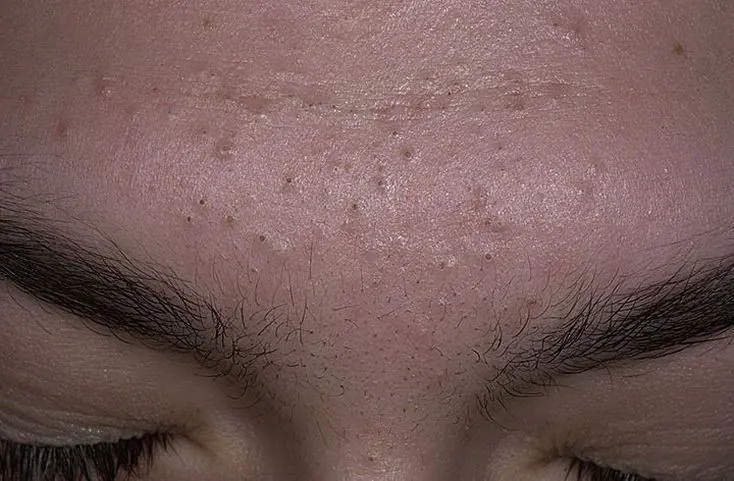
Pimples on the forehead are of the following types:
They can be with purulent heads (noticeable, inflamed) and as closed comedones (non-inflamed, white, dry), felt only with tactile contact and in bright light. They are located in the upper layer of the epidermis, quite close to the surface of the skin. They give the face an extremely unkempt appearance, but are the easiest to treat, disappearing without traces (provided they are removed correctly).
- Deep, painful subcutaneous pimples on the forehead
The process of their maturation is very long, accompanied by itching, pain, redness of the skin, and the sensation of a dense cyst-like formation when palpating the skin. They cannot be removed until they reach the last stage of development with the formation of a large purulent head.
The last type of acne is the most aesthetically unpleasant and difficult to treat. Self-medication in this case is strictly prohibited.
Measures to eliminate acne
The causes and treatment of acne in the forehead area are closely interrelated, so very often not only the help of a dermatologist is required, but also consultation with a gynecologist, endocrinologist, gastroenterologist, allergist-immunologist.
Only specialists will be able to correctly diagnose, establish the causes and prescribe adequate treatment by prescribing an individual list of drugs in suitable doses and the required concentration. It is not recommended to independently find out the causes of acne, much less determine therapy.
To successfully get rid of acne, you must adhere to the following rules and recommendations and follow them in combination:
Follow a diet with a minimum amount of fatty, spicy, sweet foods, and at the very beginning of treatment, eliminate them altogether. For normal functioning of the gastrointestinal tract, eat foods high in fiber and drink at least 1.5-2 liters of clean water per day. Avoid constipation to avoid slagging and intoxication of the body.
- Provide proper cosmetic care
Do not overdry your skin with alcohol-based cosmetics. Excessive cleanliness can lead to the opposite results - excessive dryness is perceived by the sebaceous glands as a danger to the skin, and they begin to produce more sebum and provoke new rashes. It is also not recommended to use soap, scrubs and irritants for washing. You should use products that do not change the pH balance of the skin.
Proper cleansing of the skin contributes to a more effective effect of medications. In summer, you should definitely apply sunscreen.
After washing, use disposable paper towels instead of regular terry towels, as the latter creates an ideally moist environment for bacteria to multiply. Change pillowcases on your pillow more often, wash hats.
- Follow the course of therapy prescribed by your doctor
If the reason why acne appears on the forehead is associated with a hormonal imbalance, treatment is often carried out with combined oral contraceptives with sufficient doses of synthetic estrogens (Diane 35) or drugs with a strong antiandrogenic effect (Cyproterone). For women who have not responded to other treatments, hormone therapy can be very effective. Oral contraceptives are considered the most preferred due to the low incidence of side effects.
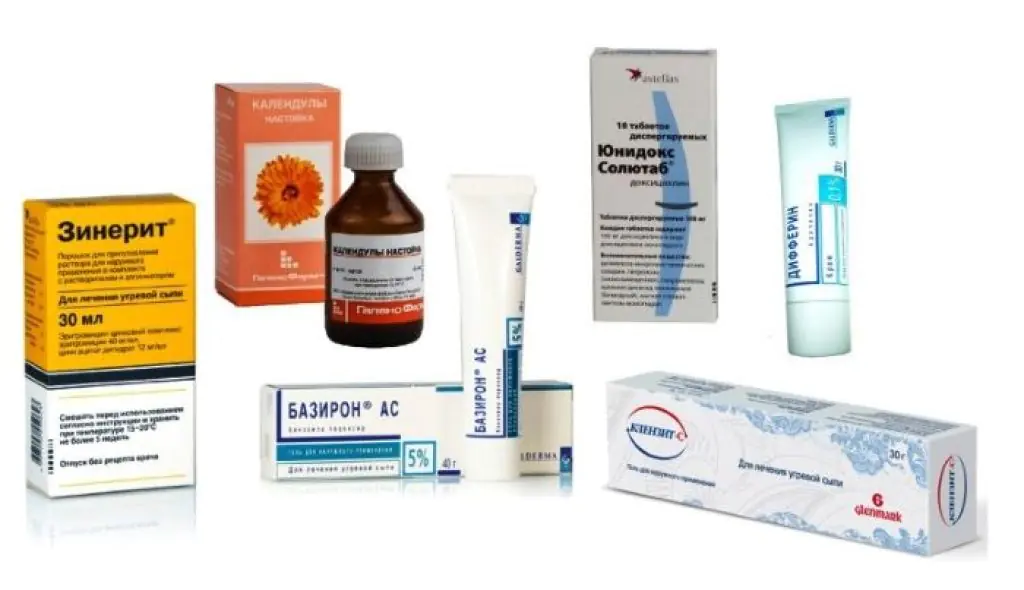
Among local remedies, preparations based on salicylic acid (sold without a prescription) and azelaic acid are widely used. Not only do they have antibacterial properties, but they also prevent the appearance of pigmented spots that often leave behind pus-filled acne. Such drugs as Baziron AS and Proderm based on benzoyl peroxide are widely prescribed. The advantage of these drugs is that bacteria do not develop resistance to the main substance and therefore its effectiveness does not decrease. Together with benzoyl peroxide, it is possible to prescribe local antibiotics and, above all, Clindamycin.
Local remedies are prescribed drugs based on synthetic retinoids, for example, Differin, but also in combination with benzoyl peroxide. In this case, retinoids are applied to the affected area for no more than 5 minutes and washed off with water. With longer contact they can cause dermatitis. Retinoids are not prescribed to women during pregnancy and breastfeeding.
Pimples on the forehead, especially subcutaneous ones, can also be treated with systemic antibiotics such as Doxycycline, Clindamycin, Dapsone, etc.
The list of all drugs successfully used in the treatment of acne is huge, but most of them have an equally impressive list of side effects, which is why it is so important to know the exact reasons why acne appears on the forehead and only then prescribe treatment.
Elimination of post-acne is one of the points of complex therapy. Now medicine and cosmetology offer a wide range of physiotherapy procedures to eliminate skin defects. Particularly popular are methods of using a laser beam. Dermabrasion and peeling are also used, so complications such as scarring and blemishes can be kept to a minimum.
Preventing acne on the forehead
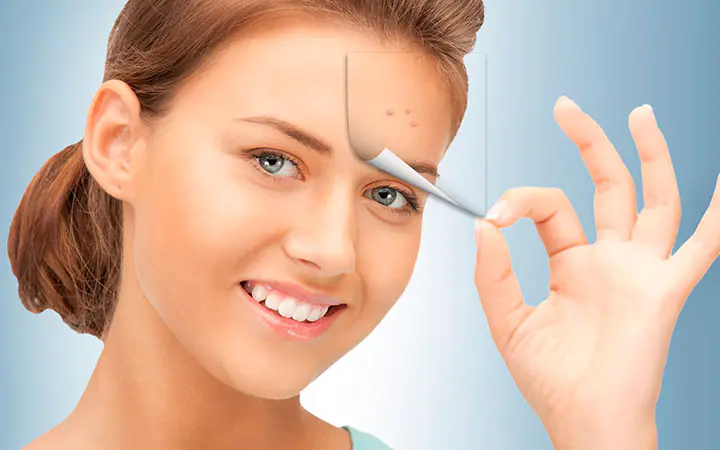
To ensure that acne on the forehead no longer bothers you, you need to make the remission period as long as possible. To do this, you should follow simple recommendations:
- Select cosmetics based on your skin type, with no comedogenic ingredients (talc, silicones, mineral oils). Avoid products that are overly aggressive and dry the skin. Remove makeup carefully.
- Do not touch your skin with dirty hands, do not rub it, and do not lean your face against contaminated surfaces.
- Do not squeeze pimples, as there is a risk of worsening the situation.
- Eat right, stop going on strict diets, drink a lot of clean water.
- Avoid strong hormonal fluctuations in the body (be less nervous, avoid uncontrolled use of oral contraceptives).
- Spend more time in the fresh air, be quite physically active, since playing sports triggers metabolic processes in the body, improves blood microcirculation, preventing stagnation.
- Avoid foods and substances that cause hypersensitivity reactions in the body.
- Take balanced vitamin complexes.
The problem of acne on the forehead can be solved provided that you contact a specialist in a timely manner, prescribe correct pathogenetic and symptomatic therapy, and strictly adhere to the prescribed regimen.
Beauty depends not only on expressive facial features, but also on healthy skin. Many men and women are faced with the problem of acne on the forehead, but it is the fairer sex who are most often worried about this problem.
Pimples on the forehead can appear for a variety of reasons, ranging from failure to comply with personal hygiene rules to serious disruptions in the functioning of the body.
Next, we will take a closer look at the causes of this problem, and also consider the most effective ways to combat this unpleasant phenomenon.
What may cause acne on the forehead?
Many girls try to find a mystical explanation for the appearance of rashes on the forehead, but in Russian folk culture there are no signs that could connect their appearance with some event.
Why do acne appear on the forehead, watch this video:
From the point of view of modern medicine, rashes on the forehead can appear due to insufficient care of the hair and facial skin, as well as due to various diseases of the gastrointestinal tract.
Causes of acne
You can completely get rid of any health problem only after eliminating the cause of the pathology. Forehead rashes are no exception.
The forehead of every person contains a huge number of sweat and sebaceous glands, the work of which is influenced by many processes occurring in the body.
Most methods of treating pathology can quickly achieve a good cosmetic effect, but if the cause of pimples is not eliminated, the problem will soon arise again.
The appearance of acne on the forehead can most often be associated with the following reasons:
- The appearance of rashes above the eyebrows often indicates problems in the intestines, but pimples on the upper forehead most often appear due to disorders in the liver and gallbladder.
- The appearance of inflammation on the forehead (as well as on other parts of the face) is often associated with an irregular or unbalanced diet. This problem can be caused by excessive amounts of fatty, spicy or sweet foods.
- Quite often, pimples on the forehead appear due to disorders of the pancreas.
- Allergic reactions to food or medications can manifest themselves in the form of various rashes on the face.
- A rash on the forehead can be a side effect from the use of antibiotics, hormonal drugs, vitamin complexes or dietary supplements.
- One of the most common reasons for the appearance of pimples on the forehead in women is the use of poor quality cosmetics.
- Pathology can be caused by hormonal imbalances, as well as during puberty in adolescents.
- Very often, redness on the forehead appears due to poor hygiene.
In the first situation, pathology indicates that a person does not take care of his facial skin enough. If acne appears due to the destruction of the protective layer of the skin, then this often occurs due to too frequent washing.
Quite often, the cause of acne lies in oily hair, when oil from the hair clogs the pores on the forehead. In such a situation, it is necessary to take care of the condition of the hair.
Treatment options
To treat acne on the forehead, both traditional medicine recipes and modern skin care preparations can be used.
Cosmetologists and dermatologists treat this pathology at a professional level, but if the cause of acne is associated with a disorder of internal organs, then without an appropriate diet and treatment it is impossible to get rid of the unpleasant symptom in the long term.
Also, such manipulations often leave scars on the skin of the face, which are much more difficult to get rid of than acne.
Many people manage to cure forehead rashes on their own, but, as with any other pathology in the body, it is always better to consult a doctor who can accurately determine the cause of acne, as well as prescribe the most effective treatment.
Medicines
Very often, antibiotics are included in medications to combat facial rashes. The following drugs are considered the most common:
- Zenerite;
- Dalatsin;
- Baziron;
- Skinoren;
- acetylsalicylic acid and many other drugs.
Doctors also recommend using the popular Vishnevsky ointment for treatment, which draws pus and fluid from areas of inflammation and also dries the skin.
Aspirin is quite effective in treating acne on the forehead.
A special mixture is made from it, which includes aspirin powder, hot water and a small amount of honey. The prepared mixture is not applied to the entire surface of the face, but pointwise, exclusively to inflamed areas.
The above-described remedy very often allows you to achieve a greater effect than the use of specialized drugs.
Folk remedies
Traditional medicine recipes can offer many effective ways to combat rashes on the forehead. Such recipes use herbs and fruits common in Russia, which contain substances that prevent the development of inflammatory processes.
Let's look at the most common traditional medicine:
- Since ancient times, cucumber has often been used in Russia to treat acne on the face. At the same time, you can either simply apply cucumber slices to pimples or use various mixtures based on the juice of this vegetable.
- Washing your face with water and lemon juice can quickly get rid of acne on your forehead. You need to wash your face with this water several times a day, but no more than three.
- A mask made from egg whites and oatmeal is very effective. This recipe helps dry out the inflamed areas of the skin, which helps the inflammatory process disappear. To prepare the product you will need one spoon of oatmeal and one egg white.
- Pimples on the forehead can be cured with a white clay mask. To prepare, you just need to add a small amount of boiled water to the clay, then mix the mixture thoroughly. This mask is applied throughout the night. You can also add calendula tincture or citrus juice to white clay to achieve greater effectiveness.
- You can get rid of acne on your face using decoctions of sage, leaves and buds of birch, chamomile, horsetail or linden. You just need to wash your face with this decoction 2-3 times a day. Acne goes away quite quickly.
- Another effective recipe is a mixture of honey and onion juice, which is applied to the inflamed areas of the skin for 30 minutes. To prepare the mixture, mix a tablespoon of onion juice with a teaspoon of honey.
- The beneficial properties of soda for fighting acne have been noticed relatively recently.
Preventing acne on the forehead
It is much better to prevent the possibility of acne on the forehead than to look for possible ways to treat it. A variety of approaches can be used to prevent this pathology.
It is very important to take care not only of the skin of the face, but also of the condition of the internal organs.
Taking care of the health of the body is the key to attractiveness and longevity. Let's consider the most effective measures to prevent the appearance of acne on the forehead:
- Cleansing the body of toxins and balanced nutrition. A glass of cold boiled water, drunk in the morning on an empty stomach, will help cleanse the body of toxins. The procedure must be carried out every day. A balanced diet will help maintain the health of your internal organs.
- Compliance with personal hygiene rules. It is very important to take care of the condition of your facial skin and hair constantly.
This video will tell you how to get rid of acne on your forehead:
Pimples on the forehead are a pressing problem for many modern people. Before treatment, it is very important to accurately determine the cause of this pathology, which may lie both in disorders of internal organs and in various pathologies of the skin.
Conclusion
Although acne significantly spoils a person’s appearance and also causes a lot of trouble, getting rid of them is quite simple. For treatment, you can use both medications and traditional medicine.
It is always worth remembering that only an experienced doctor can choose the most effective course of treatment individually for each patient.



